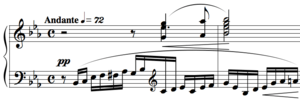Prelude in E-flat major (Rachmaninoff)

The Prelude in E-flat Major, Op. 23, No. 6 is a 1903 composition by Sergei Rachmaninoff.[1][2] It is part of Rachmaninoff's Ten Preludes, Op. 23.
Structure
The E-flat major Prelude is written in a variation form. An extended sixteenth note accompaniment is offset by a three note reoccurring melodic germ in the right hand. The prelude is a serially reoccurring set of repetitions and variations.
Measures 1-9 establish the theme - a parallel period with a cadence in G minor - that continues throughout the piece. The theme is varied in measures 9-20 in G minor, F, E flat, A flat, F, and G. A repetition of the theme occurs at measure 21, and then is drastically simplified.

Measure 28
An exchange of ascending and descending chromatic sequences occurs at measures 31 and 32, offset contrapuntally by the changes of the primary theme.

Measures 31 and 32
Towards the end of the Prelude, an emphasis is placed on the sixteenth note accompaniment, which expands into two hands, rising upward in a chromatic pattern to the finish.

Measures 39-40

Measure 19

Measure 37

Measures 23-24

Measures 37-38
Recordings
Alexis Weissenberg as well as Boris Berezovsky have recorded all the preludes written by Rachmaninoff. These works are available on various types of media. Many others recorded outstanding interpretations of the preludes, including Nikolai Lugansky and Van Cliburn.